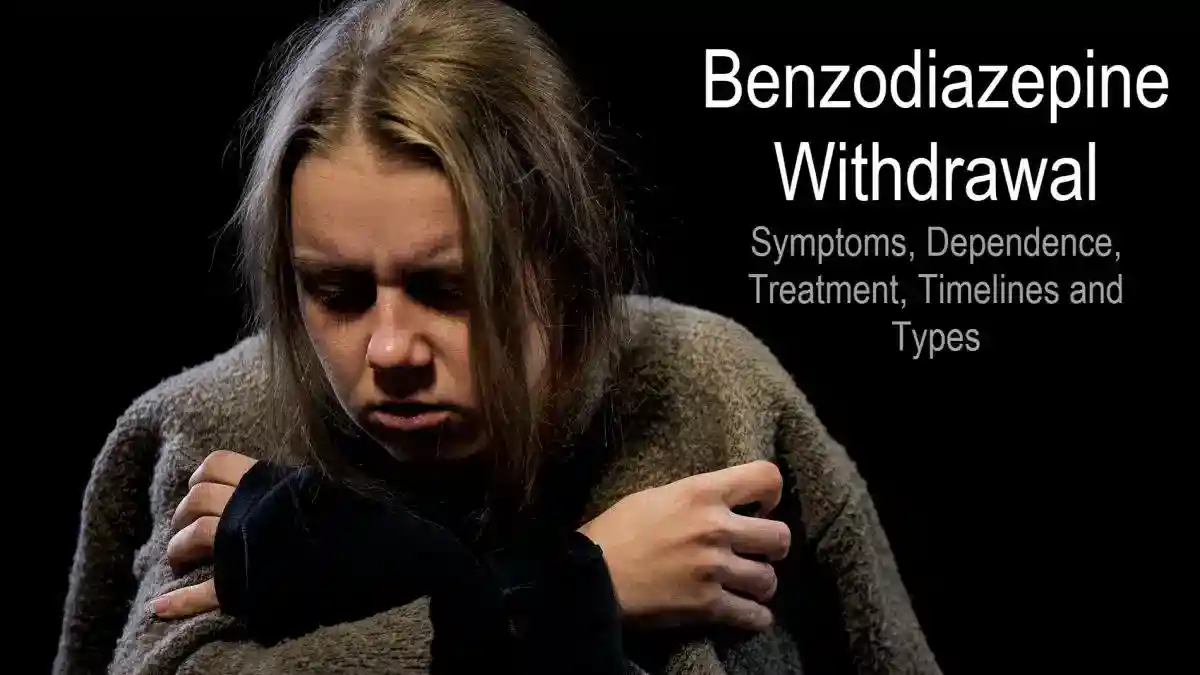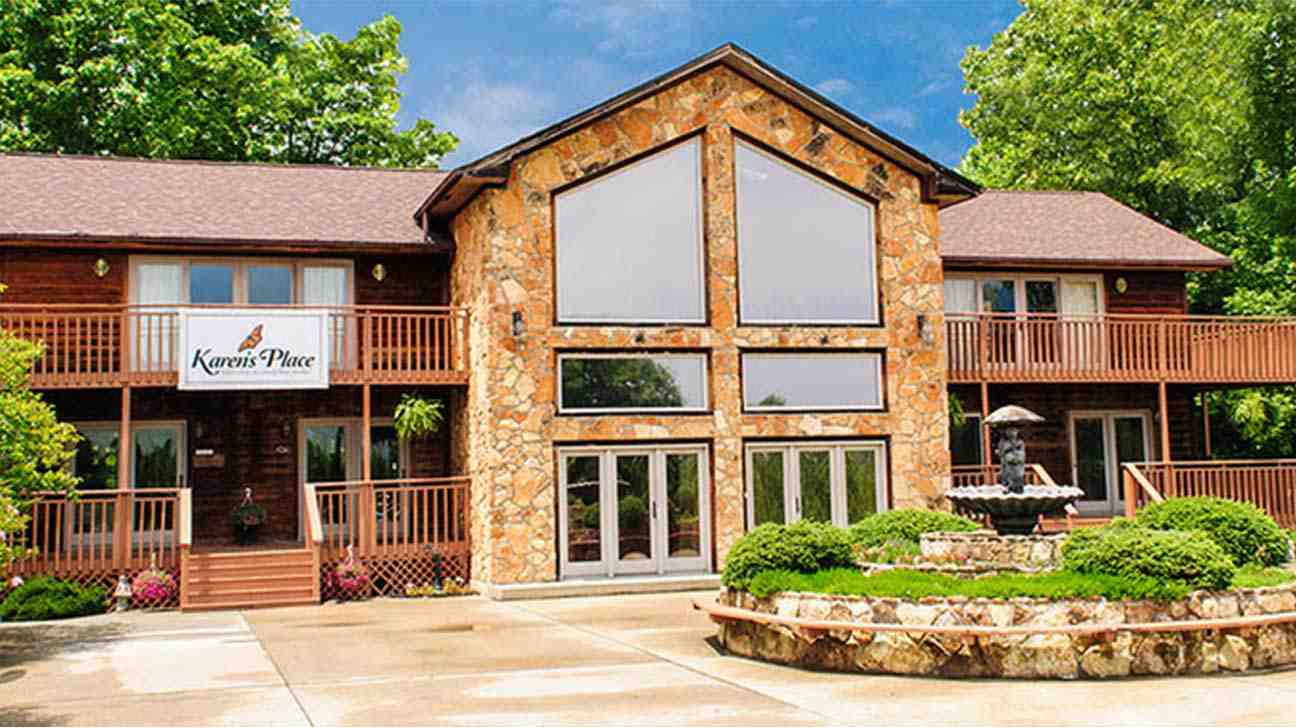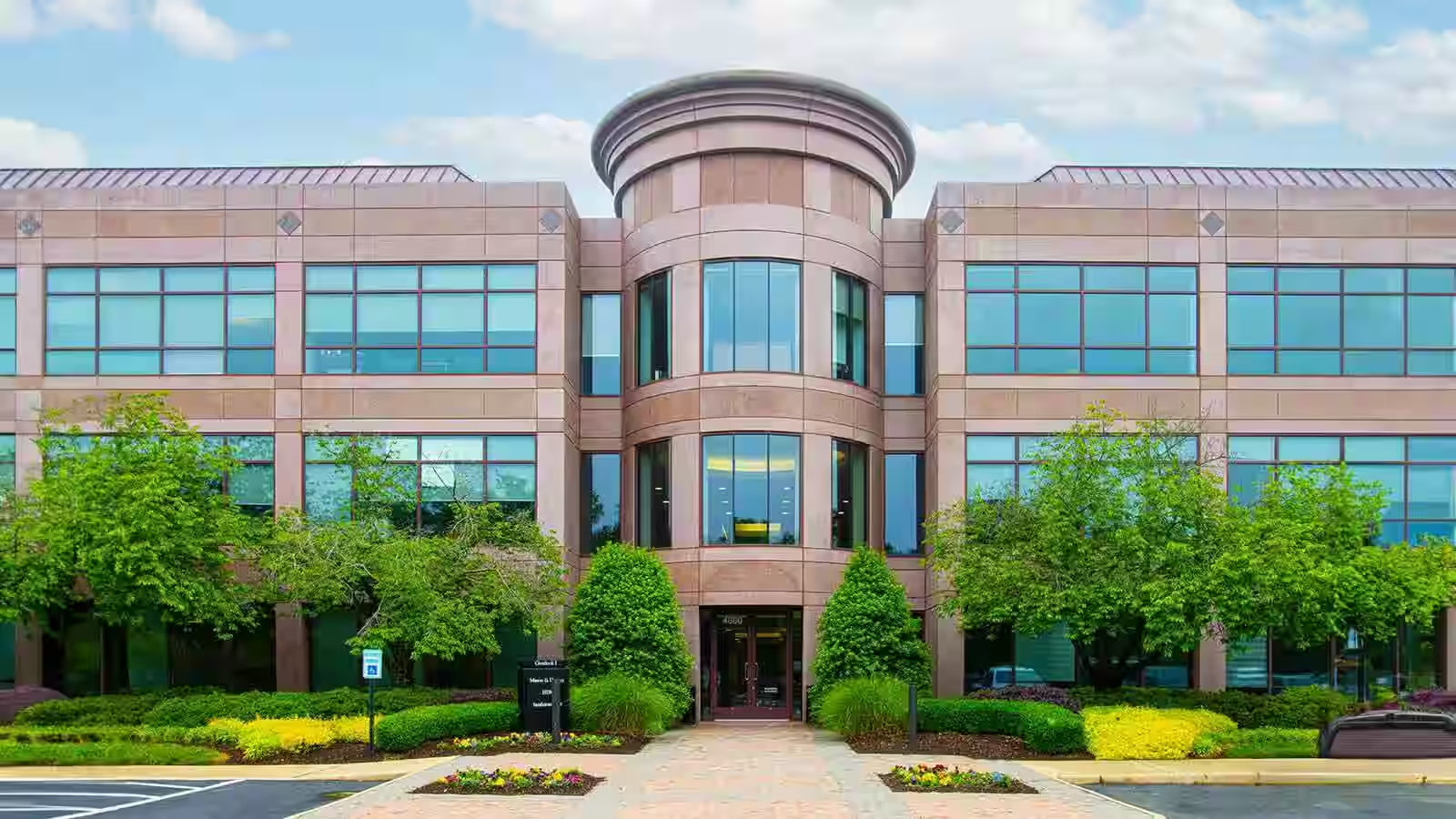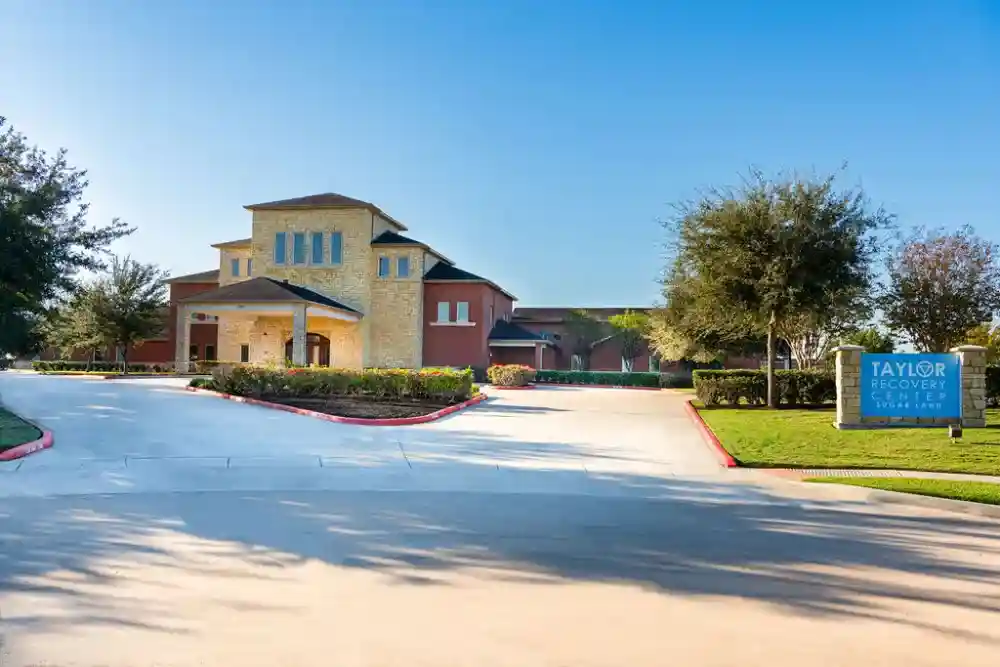
Understanding Why Traditional Approaches Fall Short
For generations, the story told about addiction was one of moral weakness or a simple failure of willpower. This viewpoint led to judgment instead of treatment, leaving millions of people to struggle alone without the support they desperately needed. It is precisely because of this outdated thinking that the world of addiction treatment has had to change so dramatically.
The Flaw in the ‘Moral Failing’ Model
Early approaches to addiction were often built on a foundation of punishment. The belief was that if the consequences were painful enough, a person would simply choose to stop using drugs or alcohol. This model completely overlooks the powerful biological and psychological forces that drive addiction.
Imagine trying to punish someone out of having asthma; it’s an attempt to treat a complex medical condition with blame, rather than addressing the root cause. This method fails because it misunderstands the basic nature of addiction. It is not a choice, but a compulsion fueled by profound changes to the brain’s chemistry and function, leading to destructive cycles of shame and relapse.
Addiction as a Medical Condition
Modern science provides a much clearer and more compassionate picture. We now understand that addiction is a chronic, relapsing brain disease. It is defined by compulsive substance seeking and use, even when faced with devastating consequences. The condition literally rewires the brain’s circuits for reward, stress, and self-control, which is why willpower alone is almost never enough to overcome it.
The scale of this public health crisis is enormous. In 2021, an estimated 46.3 million people in the United States aged 12 or older had a substance use disorder (SUD). Yet, a staggering 93.7% of them received no treatment at all. Explore the full scope of these statistics here.
To see how this treatment gap affects different groups of people, let’s look at the numbers. The data below shows how many people in various age groups are dealing with a substance use disorder versus how many are actually able to get help.
The Addiction Treatment Gap by Age Group
A comparison of substance use disorder (SUD) prevalence versus treatment access rates across different age demographics in 2021, based on data from the National Survey on Drug Use and Health.
| Population Group | SUD Prevalence Rate | Received Any Treatment (% of those with SUD) | Unmet Need (% of those with SUD) |
|---|---|---|---|
| Adolescents (12-17) | 9.4% (1 in 11) | 11.2% | 88.8% |
| Young Adults (18-25) | 24.3% (1 in 4) | 8.1% | 91.9% |
| Adults (26 or Older) | 15.5% (1 in 6) | 6.0% | 94.0% |
As the table shows, young adults face the highest rates of substance use disorder but have alarmingly low access to care. The hard truth is that the vast majority of people in every age group who need help are not receiving it, highlighting a critical need for more accessible and effective treatment options.
Why One-Size-Fits-All Treatment Fails
Because addiction affects every person differently—touching their biology, psychology, social life, and environment—a single, cookie-cutter solution is destined to fail. An approach that works wonders for one individual may be completely ineffective for another. This inherent complexity is why a personalized, multi-faceted strategy is vital for lasting recovery.
The chart below from the National Institute on Drug Abuse illustrates the shifting trends and diverse nature of substance use, reinforcing the need for varied treatment options.
Effective treatment works more like an orchestra than a solo performance. The different types of addiction therapy are the instruments, and each one plays a crucial role.
- Behavioral therapies might be the strings, providing the core emotional melody of recovery by addressing thoughts and behaviors.
- Medication-assisted treatment could be the percussion, offering a steady, stabilizing rhythm to manage cravings and withdrawal.
- Group support can be seen as the woodwinds, adding harmony and a sense of connection with others.
When these elements work in concert, they create something far more powerful than any single instrument could produce alone. This integrated approach addresses the whole person, not just their substance use. It provides the tools, support, and medical care needed to manage the disease and build a fulfilling life. This guide will explore each of these vital instruments, helping you understand how they contribute to the symphony of healing.
Behavioral Therapies: Training Your Brain for Success
If addiction works by rewiring the brain’s circuits, then behavioral therapies are the tools we use to wire it back for a healthier life. You can think of it as a form of mental personal training. These therapies focus on action, teaching you practical skills to manage your thoughts and behaviors. By learning to handle internal triggers—like negative thoughts or cravings—you can gain real control over your external actions, including the impulse to use substances.
These approaches are a cornerstone of modern treatment. The diagram below shows how they fit into the broader landscape of addiction care, often working alongside medical and supportive methods.
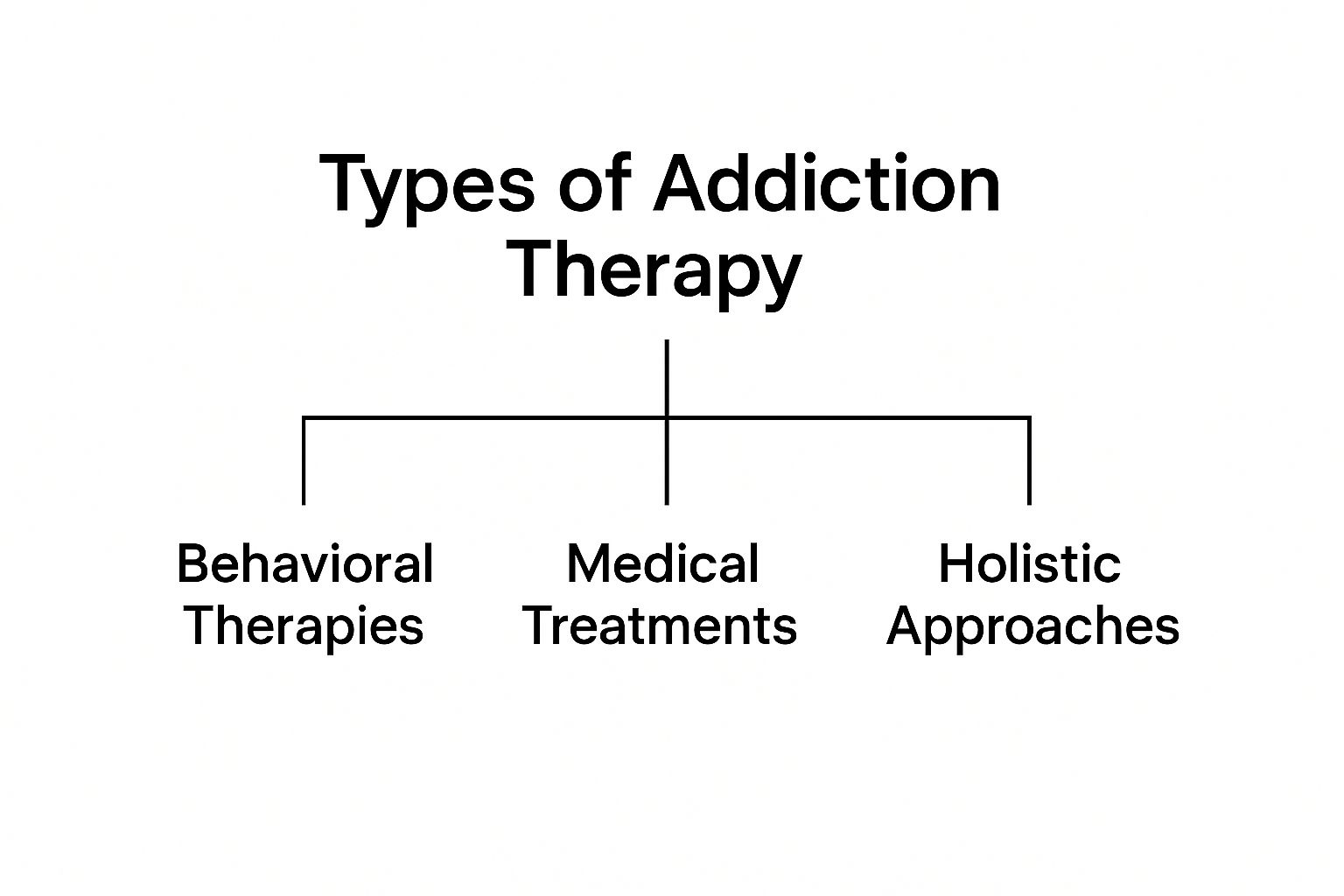
As you can see, behavioral therapies are a central pillar, providing the skills necessary for long-term recovery.
Cognitive Behavioral Therapy (CBT): Rewiring Your Thought Patterns
One of the most widely used approaches is Cognitive Behavioral Therapy (CBT). It operates on a simple but powerful idea: our thoughts, feelings, and behaviors are all connected. CBT helps you become a detective of your own mind, learning to spot the automatic negative thoughts that often lead to substance use.
Working with a therapist, you’ll learn to examine these thoughts, challenge their validity, and replace them with more balanced and realistic alternatives. It’s not about pretending everything is perfect, but about breaking a destructive cycle. By changing the initial thought, you can prevent the downward spiral into negative feelings and harmful actions.
Motivational Interviewing (MI): Finding Your ‘Why’ for Change
Rather than having a therapist tell you why you need to change, Motivational Interviewing (MI) is a conversation designed to help you discover your own reasons. It’s a partnership, not a lecture. The therapist acts as a guide, asking thoughtful questions to help you work through any uncertainty or mixed feelings you have about recovery.
This process helps build motivation that comes from within, which is far more powerful than being pushed by someone else. MI is especially helpful for people who feel hesitant or resistant to treatment because it respects their autonomy and empowers them to take ownership of their journey.
Contingency Management (CM): Reinforcing Positive Steps
Contingency Management (CM) uses the straightforward principle of positive reinforcement. It provides tangible rewards for reaching specific recovery goals, such as passing a drug screening. Think of it like getting a bonus at work for hitting a sales target; the incentive directly encourages the behavior you want to see.
Rewards are often simple, like vouchers for groceries or movie tickets, but they provide immediate, concrete feedback for making positive choices. This external encouragement can be a powerful driver, especially during the challenging early phases of recovery when building momentum is critical.
The success of these behavioral methods has made them a dominant force in treatment. In fact, therapy-based approaches are expected to account for over 50% of the addiction treatment market. Techniques like motivational interviewing and contingency management are proven to lower relapse rates by giving individuals essential coping skills. You can learn more about addiction treatment market projections here.
To help clarify how these therapies differ, the following table breaks down their core functions and ideal applications.
Behavioral Therapy Types Comparison
The table below offers a side-by-side look at CBT, MI, and CM, highlighting their different methods, typical timeframes, and the situations where each is most effective.
| Therapy Type | Primary Method | Duration | Best For |
|---|---|---|---|
| Cognitive Behavioral Therapy (CBT) | Identifying and reframing destructive thought patterns to alter behavior. | 12-20 sessions | Individuals with co-occurring mental health conditions like anxiety or depression. |
| Motivational Interviewing (MI) | Collaborative conversation to resolve ambivalence and build intrinsic motivation for change. | 1-4 sessions | People who are resistant or unsure about starting treatment. |
| Contingency Management (CM) | Providing tangible rewards (e.g., vouchers) for verified abstinence and positive behaviors. | 12+ weeks | Encouraging initial abstinence and continued engagement, especially for stimulant use. |
This comparison shows that while all three are behavioral therapies, they target different aspects of the recovery process, from internal thought patterns to external motivation.
In the end, these therapies provide a flexible and powerful toolkit for recovery. Their goal isn’t just to achieve abstinence; it’s to teach the fundamental cognitive and emotional skills needed to build a strong, satisfying, and resilient life.
Medication-Assisted Treatment: Science-Backed Chemical Balance
Many people think Medication-Assisted Treatment (MAT) is simply trading one substance for another. In reality, MAT acts like giving crutches to someone with a broken leg—essential support while the brain stabilizes after the chemical upheaval of long-term substance use.
Long-term substance use physically rewires brain circuits that regulate reward, pleasure, and self-control. This rewiring drives intense cravings and painful withdrawal that are nearly impossible to overcome without medical assistance.
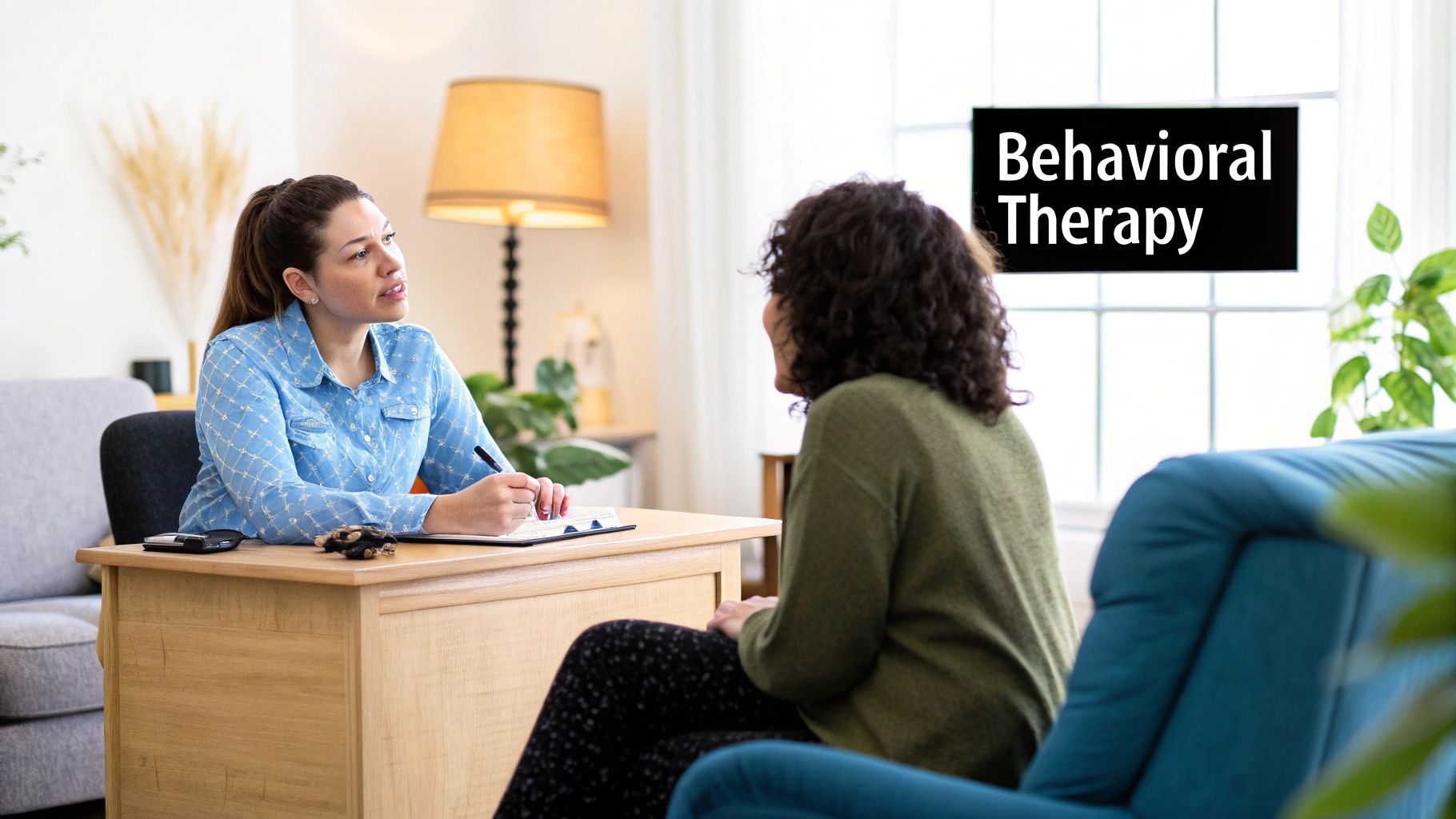
How MAT Restores Brain Chemistry
MAT uses FDA-approved medications to gently occupy the same receptors that addictive substances target. Instead of sudden highs and lows, these medications provide a controlled activation that eases withdrawal and lowers cravings.
By normalizing neurotransmitter levels, MAT restores a chemical balance that clears mental fog and steadies the body. With this stability, a person can fully participate in counseling, behavioral therapies, and social support.
Common Medications Used in MAT
Different disorders call for different medications:
- Methadone: A full opioid agonist that blocks withdrawal and cravings by fully activating opioid receptors. It is dispensed daily under supervision at specialized clinics.
- Buprenorphine: A partial opioid agonist with a “ceiling effect,” which limits activation at higher doses and reduces overdose risk. It can be prescribed in a doctor’s office. For more details, see opioid addiction treatment options.
- Naltrexone: An opioid antagonist that blocks the euphoria and sedation of opioids. Non-addictive and free of dependence, it requires complete detox before use and also treats Alcohol Use Disorder (AUD).

This diagram highlights how a full agonist like methadone fully activates the receptor, while a partial agonist like buprenorphine offers limited activation, enhancing its safety profile.
Why Medication Is Only Half the Equation
Medication lowers the biological barriers to recovery, but it doesn’t address habits, thoughts, or relationships on its own. The most effective programs pair MAT with behavioral therapies such as Cognitive Behavioral Therapy (CBT) and group counseling.
These therapies teach a person to:
- Identify and cope with triggers
- Develop healthier thought patterns
- Rebuild damaged relationships
- Create meaning and purpose in recovery
Combined treatment is a game-changer: people on MAT for opioid use disorder are more than 50% less likely to die from overdose compared to those without this integrated care. By treating the body and mind together, MAT offers a clear path toward lasting recovery.
Call Now – Your Journey to Recovery Begins Today!

Take the first step towards a healthier life! Call now to connect with our compassionate team and start your recovery journey today. Your path to healing awaits!
Our recovery specialists are available 24/7 to provide support, and all calls are confidential and free. Reach out anytime – we’re here to help!
Group Therapy and Peer Support: Breaking Isolation Together
Addiction often builds its own lonely world, trapping people in a cycle of shame and secrecy. While individual therapy focuses on personal thoughts and medication helps with brain chemistry, **group therapy** directly confronts this deep-seated isolation. It reframes recovery not as a solitary battle but as a shared journey, showing you that you are not in this fight alone.
Imagine trying to scale a difficult mountain by yourself versus climbing with an experienced team. In a group, members learn from one another, offer support during tough spots, and celebrate every milestone reached. This collective effort creates a powerful sense of momentum that is hard to achieve on your own.
The Healing Power of Shared Experience
The foundational strength of group therapy comes from shared experience. There is a unique power in hearing someone else put into words the exact fears and challenges you thought only you were facing. This moment of connection helps to dissolve the shame that addiction thrives on by showing you that your experience is not abnormal.
That quiet, internal “me too” can be more healing than any clinical textbook explanation. In this setting, the therapist’s role is not to lecture but to facilitate, ensuring the conversation remains a safe, respectful, and constructive space for everyone to share.
The image here shows a common group therapy arrangement. Participants sit in a circle, a deliberate choice that promotes open communication and equality. This setup physically removes barriers, making sure every person is seen and heard, which strengthens the feeling of community and mutual respect.
Different Formats for Group-Based Treatment
Group support isn’t a single approach; it’s one of the most adaptable types of addiction therapy. It comes in several formats to meet different needs and recovery stages.
- 12-Step Programs: Organizations like Alcoholics Anonymous (AA) and Narcotics Anonymous (NA) are the most widely known examples. They offer a structured path to recovery through a series of steps, guided entirely by peer support. A central element is sponsorship, where a member with more experience in recovery mentors a newcomer.
- Psychoeducational Groups: These sessions function like classes, focused on teaching members the science behind addiction, its impact on the body and brain, and the mechanics of recovery. The aim is to give people the knowledge and tools they need to understand their condition and make informed decisions.
- Skills Development Groups: These are highly practical sessions designed to rebuild life skills that may have been weakened by addiction. Topics often include stress management, healthy communication, managing anger, and developing detailed relapse prevention plans for real-world scenarios.
- Therapeutic Communities: These are intensive, often residential programs where recovery becomes a full-time, immersive way of life. Members live and work in a structured environment, practicing healthy social roles and holding each other accountable, essentially forming a supportive, family-like community.
The Unique Benefits of a Group Setting
Beyond simply ending isolation, group therapy provides benefits that are difficult to replicate. The group itself becomes a dynamic force for change, creating a space for personal growth.
A key advantage is accountability. When you state your recovery goals to a group of peers, you create a built-in support system that wants to see you succeed. Members offer encouragement, celebrate progress, and gently challenge excuses, providing firm but compassionate motivation.
Hearing how others handle their triggers and setbacks also offers fresh perspectives you might not have considered. Most importantly, the group serves as a safe laboratory for social skills. Many people in recovery must relearn how to connect with others without the aid of substances. Group therapy is the perfect, low-stakes environment to practice being honest, showing empathy, and establishing healthy boundaries.
Inpatient vs Outpatient: Matching Treatment to Real Life
After exploring the different therapies available, the next practical question is where this healing will take place. Choosing between inpatient and outpatient treatment isn’t about picking a “better” option; it’s about finding the level of support that fits your unique needs and current life situation. This decision is a cornerstone of a successful recovery plan.
Inpatient Treatment: An Immersive Safety Net
Inpatient treatment, often called residential treatment, offers a structured, 24/7 care environment. Think of it as a dedicated workshop for healing—it removes you from the daily triggers and pressures of your regular life so you can focus completely on recovery. This immersive approach is often essential for people with severe substance use disorders, significant co-occurring mental health conditions, or an unstable home environment that might hinder progress.
Key benefits of inpatient treatment include:
- Constant medical and clinical support, which is critical during detoxification and for managing complex health issues.
- A highly structured and stable setting that provides a routine and removes access to substances.
- Intensive therapy schedules packed with multiple individual and group sessions each day.
This level of care provides the most thorough support possible, helping you build a strong foundation before you return to your everyday life.
Outpatient Treatment: Integrating Recovery into Daily Life
In contrast, outpatient treatment is designed for integration. It allows you to live at home and keep up with work, school, or family commitments while attending therapy sessions on a regular schedule. This model is effective for individuals with less severe addictions, a solid support system at home, and the self-motivation to stay on track. Outpatient care is one of the most common formats for engaging in different types of addiction therapy.
Primary advantages of outpatient programs are:
- Flexibility to maintain your daily responsibilities while receiving consistent, professional care.
- Lower cost when compared to residential programs, making it a more accessible choice for many people.
- Immediate real-world application of the coping skills you learn in therapy to the challenges you face daily.
This format allows you to practice recovery skills in real time, navigating life’s hurdles with the steady guidance of your treatment team.
The world of addiction care extends beyond this simple pair of choices. As the levels of care model from Wikipedia illustrates, treatment exists on a continuum.
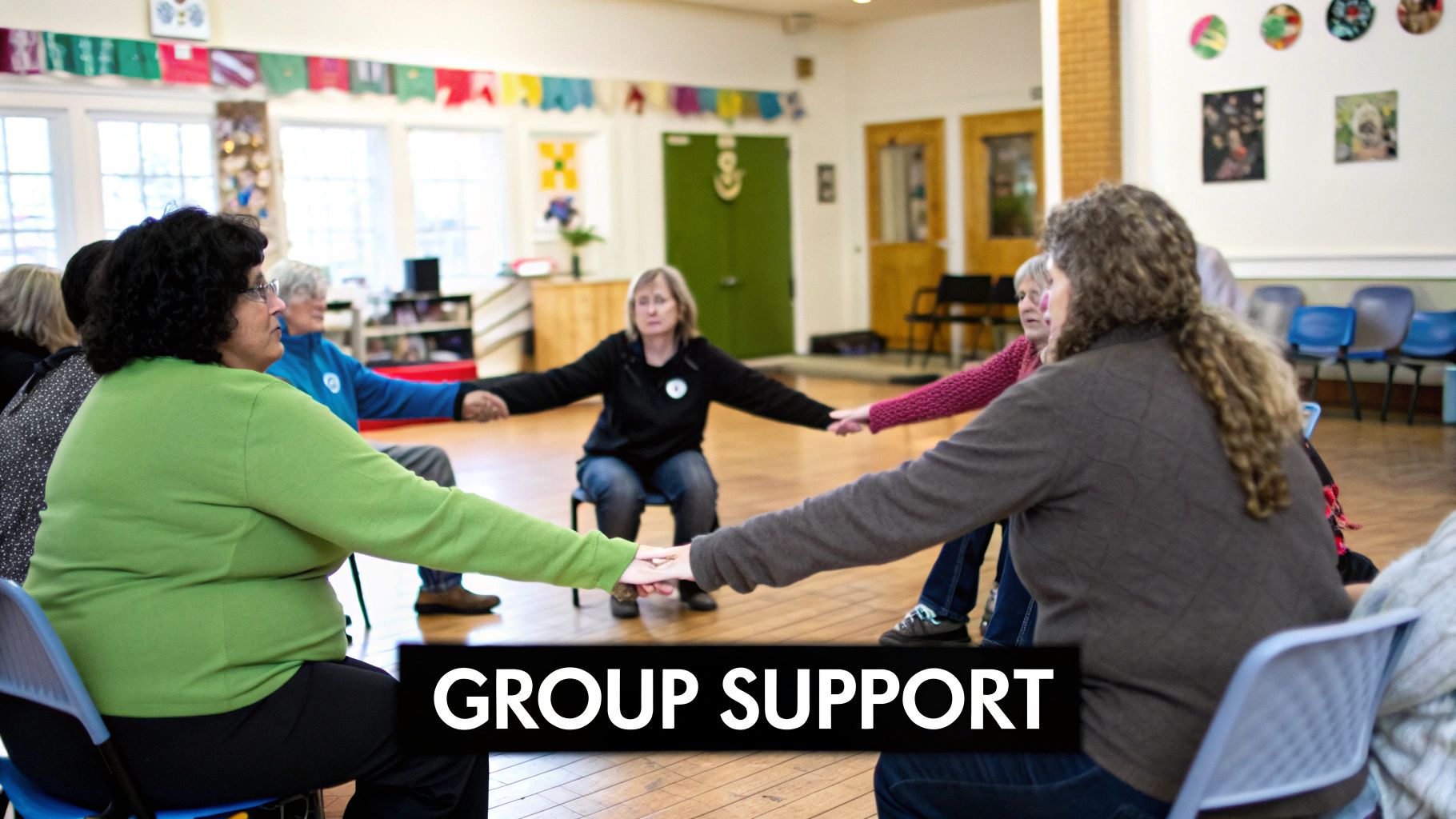
This shows that treatment intensity is adjustable, with options like partial hospitalization offering a middle ground between full-time residential care and standard outpatient sessions.
Making the Right Choice: A Direct Comparison
Selecting the right level of care is a major step. The table below outlines the key differences to help you think through which path might be the best starting point for your circumstances.
| Feature | Inpatient Treatment | Outpatient Treatment |
|---|---|---|
| Living Situation | Reside at the treatment facility 24/7 | Live at home, travel to the facility for sessions |
| Structure | Highly structured days with constant support | Flexible schedule with several hours of therapy per week |
| Intensity | High-intensity, immersive therapeutic environment | Lower intensity, integrated with daily life |
| Medical Supervision | Around-the-clock medical and clinical staff | Access to medical staff during scheduled hours |
| Best For | Severe SUDs, co-occurring disorders, unstable homes | Milder SUDs, strong support systems, work/family needs |
This decision is one of the most important you will make on your recovery journey. For a deeper dive into making this choice, you might be interested in our guide comparing inpatient and outpatient rehab.
Finally, it’s important to remember that these are not mutually exclusive paths for life. Many people start with the security of inpatient care to build a solid foundation and then “step down” to an outpatient program to continue their growth. The right path is simply the one that provides the appropriate level of support to keep you safe as you build the skills for lasting change.
Innovative Therapies: Beyond Traditional Talk Therapy

While changing behaviors and thoughts is a cornerstone of recovery, some of the deepest wounds that fuel addiction are not easily reached with words. Specialized therapies are designed to access and heal these underlying issues, from deep-seated trauma to emotional blocks and even patterns in brain activity. These methods recognize a fundamental truth: for many people, talking about an experience isn’t enough to truly move past it.
Call Now – Your Journey to Recovery Begins Today!

Take the first step towards a healthier life! Call now to connect with our compassionate team and start your recovery journey today. Your path to healing awaits!
Our recovery specialists are available 24/7 to provide support, and all calls are confidential and free. Reach out anytime – we’re here to help!
Unlocking Trauma with EMDR
Addiction often serves as a way to cope with unresolved trauma. Eye Movement Desensitization and Reprocessing (EMDR) is a highly structured therapy designed to help the brain correctly process traumatic memories that have become “stuck.” Imagine a traumatic memory as a corrupted computer file that keeps crashing the system. EMDR works like a repair tool to fix that file.
In an EMDR session, a therapist guides you to make specific eye movements (or use other forms of bilateral stimulation) while you briefly hold the traumatic memory in your mind. This technique helps your brain’s own information-processing system to finally file the memory correctly. The memory itself doesn’t vanish, but its painful emotional charge is neutralized, weakening its ability to trigger cravings or distress. This makes it one of the most focused types of addiction therapy for trauma.
Creative Expression as a Pathway to Healing
When words fail, art and music can provide a powerful alternative language. These therapies use the creative process itself as a tool for exploring feelings, reducing stress, and building self-awareness. The point isn’t to paint a masterpiece or compose a symphony; it’s about using the act of creating to give form to internal struggles that are otherwise hard to express. For many, this becomes an essential piece of their recovery journey. You can learn more in our article about therapy in addiction recovery.
The image below shows a group engaged in art therapy activities.

This illustrates that the emphasis is on the creative act—whether it’s painting, drawing, or working with clay—not the final product. This focus allows for a non-verbal release of complex emotions that might otherwise remain buried.
Building Awareness and Regulating the Brain
Other modern therapies work by directly training the brain for greater self-control and emotional stability. By strengthening the mind’s ability to manage itself, these methods are excellent complements to talk therapy.
Mindfulness-Based Relapse Prevention (MBRP): This therapy teaches you how to become a calm observer of your own thoughts and urges. It’s like learning to stand on the bank of a river and watch your thoughts drift by, instead of getting swept away by the current. This practice creates a crucial pause between an urge and the action, giving you the power to choose a different path. Research shows it can significantly lower relapse rates, particularly for individuals also dealing with depression.
Neurofeedback: Think of this as physical therapy for your brain. It is a direct brain-training method that uses sensors to monitor your brainwave activity. This information is presented back to you in real-time, often as a video game or sound. By watching this feedback, you learn to consciously guide your brain activity toward healthier, more stable patterns, strengthening the neural circuits for focus and impulse control.
Wilderness Therapy: This approach takes therapy outdoors, combining adventure and therapeutic guidance. By removing you from your everyday environment and its triggers, wilderness therapy uses the challenges of nature as powerful metaphors for recovery. Activities like hiking and teamwork build genuine self-reliance, resilience, and problem-solving skills that translate directly to a life of sobriety.
These specialized therapies add powerful tools to the recovery process. They offer targeted ways to heal the whole person—addressing the mind, body, and past experiences in a way that is profoundly personal and effective.
Navigating Setbacks and Building Long-Term Success
It’s important to understand a core truth about recovery: the path forward is rarely a straight line. Think of it like learning to play an instrument or mastering a new sport. You’ll have days where you hit every note perfectly, and other days where you stumble. These stumbles aren’t failures; they are part of the learning process and are essential for building long-term resilience.
Relapse is a common challenge on this journey. Research indicates that between 40% and 60% of individuals treated for a substance use disorder will experience a relapse. This statistic isn’t meant to be discouraging. Instead, it frames addiction as a chronic condition, much like diabetes or hypertension, which require ongoing management to prevent a recurrence. The challenge is magnified by the fact that over 93% of people who needed help for a substance use disorder in the past year didn’t receive any treatment at all, leaving them without the tools to manage their condition. Explore more on addiction and recovery statistics.
Understanding that setbacks are possible is the first step in preparing for them. A relapse is rarely a sudden event that comes out of nowhere. It’s a progressive process that unfolds in stages, moving from an internal struggle to an external action.
This model shows that a physical relapse is the final step, typically preceded by clear emotional and mental stages. Learning to recognize these early warning signs—like withdrawing from others in the emotional stage or romanticizing past use in the mental stage—is a critical skill taught in many types of addiction therapy.
Developing a Personalized Relapse Prevention Plan
The best way to prepare for these challenges is to build a proactive, personalized relapse prevention plan during therapy. This isn’t a generic checklist but a dynamic guide tailored to your unique triggers, strengths, and challenges. It acts as your personal playbook for navigating difficult moments.
This plan, developed with your therapist, includes several key components:
- Identifying Early Warning Signs: You learn to become an expert on your own internal signals. This means recognizing the subtle shifts in your mood, thoughts, or behaviors that indicate you might be heading toward a setback, such as neglecting self-care or feeling resentful.
- Creating a Robust Support Network: Your plan will have a list of specific people to call when you spot a warning sign, whether it’s a sponsor, a therapist, or a trusted friend. Consistent engagement with aftercare programs and peer support groups is a vital part of long-term success.
- Deploying Coping Strategies: This is where you put skills learned in therapy, like CBT or mindfulness, into practice. Your plan will detail specific actions to take when you face a trigger, such as doing a grounding exercise, going for a run, or immediately calling a support person instead of acting on an urge.
Overcoming Barriers to Continued Care
Creating a solid plan is one thing; sticking to it when life gets complicated is another. Long-term recovery often depends on staying engaged with treatment, which can present its own real-world obstacles.
A common hurdle is figuring out insurance for continued care. It helps to view outpatient therapy, group sessions, or sober living as essential investments in your health, not just extra costs. Many treatment facilities have dedicated staff who can help you understand your benefits and find ways to make ongoing care affordable.
Perhaps the greatest challenge is keeping your motivation strong after the initial excitement of recovery fades. When life gets stressful, returning to old habits can seem tempting. This is why it’s so important to stay connected to your reasons for getting sober. Regularly celebrating small wins, finding new hobbies that bring you joy, and making your support community a priority helps keep recovery feel meaningful and worthwhile.
Call Now – Your Journey to Recovery Begins Today!

Take the first step towards a healthier life! Call now to connect with our compassionate team and start your recovery journey today. Your path to healing awaits!
Our recovery specialists are available 24/7 to provide support, and all calls are confidential and free. Reach out anytime – we’re here to help!
Your Recovery Action Plan: Taking the First Step
Understanding the different types of addiction therapy is a crucial starting point. But knowledge alone doesn’t create change. This section is your guide to turning information into action and building a real plan for getting help. It’s time to move from knowing to doing.
Assess Your Unique Situation
Before you can find the right map, you need to know your starting point. This requires an honest look at your circumstances, creating a blueprint for your recovery. Think about key factors like the substance involved, how long you’ve been using it, and your daily environment.
Do you have a strong support system of family and friends, or would a more structured program be beneficial? Are you also dealing with co-occurring conditions like anxiety, depression, or past trauma? Answering these questions helps you identify a treatment approach that truly aligns with your life and needs.
Researching Quality Providers
With a clearer picture of what you need, you can begin searching for treatment providers. Look for facilities with licensed, experienced staff whose programs are built on evidence-based practices. Finding a community of peers who understand your journey is also a vital part of the process.
Support comes in many forms, and it’s important to find the right fit. The screenshot below shows just how many different kinds of addiction recovery groups exist.
This variety, from traditional 12-step models to secular alternatives like SMART Recovery, shows that there is no single path. The goal is to find a community and a philosophy that resonates with you personally.
Preparing for the First Consultation
Think of your first call with a treatment center as a two-way interview. You are evaluating them just as much as they are getting to know you. Have a list of questions ready to make sure the program is the right match.
- What specific types of addiction therapy do you offer?
- What is the typical staff-to-patient ratio?
- How do you involve family in the treatment process?
- What does aftercare planning look like to support long-term success?
Fortunately, treatment options and public awareness are growing. The global addiction treatment market is expected to reach USD 31.20 billion by 2032, a clear sign that addiction is increasingly recognized as a treatable health condition. This growth means more quality choices are becoming available for those seeking help. Discover more insights on the expansion of treatment services.
Taking this first step can feel difficult, but you don’t have to do it by yourself. If you are ready to start but are unsure where to turn, help is available right now.
Contact Addiction Helpline America today for confidential, no-cost guidance. Our trained specialists are available 24/7 to help you navigate your options and take the first step toward a healthier life. Visit Addiction Helpline America or call us to connect.
Our helpline is 100%
free & confidential
If you or someone you care about is struggling with drug or alcohol addiction, we can help you explore your recovery options. Don’t face this challenge alone—seek support from us.
Programs
Resources
Will my insurance
cover addiction
treatment?
We're ready to help
Find the best
drug or alcohol treatment
center
Are you or a loved one struggling with addiction? Call today to speak to a treatment expert.





